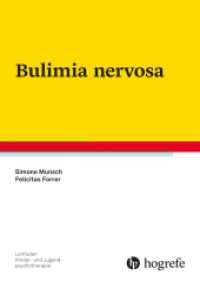- ホーム
- > 洋書
- > 英文書
- > Psychology
基本説明
Provides a comprehensive framework for collecting and analyzing reliable person-environment-behaviour data in real-world settings that rarely match the controlled conditions described in typical texts.
Full Description
Research into spatial influences on people's everyday activities and experiences presents many conceptual and methodological complexities. Written by leading authorities, this book provides a comprehensive framework for collecting and analyzing reliable person-environment-behavior data in real-world settings that rarely resemble the controlled conditions described in typical texts. An array of research designs are illustrated in chapter-length examples addressing such compelling issues as spatial patterns of voting behavior, ways in which disabilities affect people's travel and wayfinding, how natural and built environments evoke emotional responses, spatial factors in elementary teaching and learning, and more. A special chapter guides the student or beginning researcher to craft a successful research proposal.
Contents
1. An Overview of Spatial and/or Environmental Influences in Human Activities and Experiences
I. Comprehending Data Recording and Measurement to Generate Information in Scientific Inquiry
2. Data and Measurement to Generate Information
3. Collecting Data and Generating Information in a Scientific Mode
II. Collecting Data and Representing Information
4. The Purpose of Collecting and Matching Data and Analysis
5. Qualitative and Survey Approaches to Collecting Data and Generating Information
6. Collecting Information from Sampled Populations Using Probability and Nonprobability Designs
7. Extrapolating from Controlled Conditions to the Real World
III. Activities in Environments
8. Modeling Social-Environmental Factors Associated with Spatial Patterns of Voter Support for Political Parties
9. Intellectually Challenged People Interacting with Their Environment
10. Spatial Competence of Blind and Visually Impaired People When Performing Activities in Different Spaces
IV. Activities and Spaces
11. Decision Process and Choice in the Residential Relocation of Retirees
12. Sex Roles and the Gendering of Activities and Spaces
13. Spatial Structural Influences on Activities in an Elementary Classroom Environment
V. Experiences and Environments
14. Experiences in Everyday Environments
15. Aesthetic Experiences in Environments
VI. Experiences and Spaces
16. Deriving Metropolitanwide Spatial Patterns of Perceived Quality-of-Life Dimensions
17. Reflecting the Nature of Cognitive Spaces from Perceived Relations
18. Modeling Group Conservation Perspectives
VII. Planning Research: The Common Sense of a Research Proposal
19. Mapping a Strategic Plan for Research








